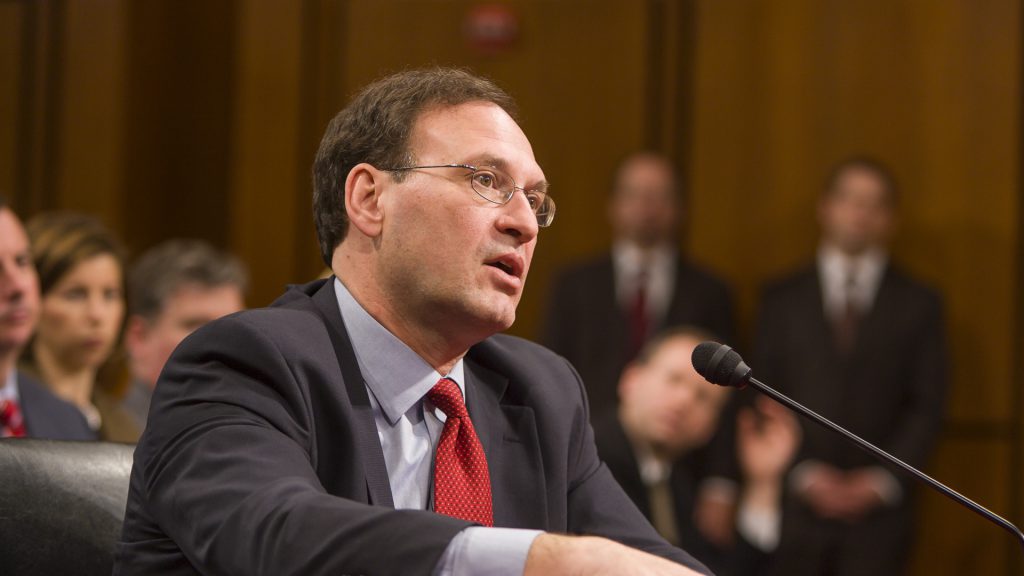
Published April 23, 2020
In a rant on Vox, Ian Millhiser condemns Justice Alito as a “defender of white racial innocence”—indeed, as the Court’s “foremost defender” of that supposed cause—and as a proponent of a “brand of racial resentment.” But his charges are baseless smears.
Millhiser broadly contends that Alito “bristl[es] at the idea that racism still shapes many policymakers’ decisions today, and that the legacy of past racism still affects people of color.” He seems not to grasp that it is possible to believe that racism still has those effects and to believe that a judge’s role in deciding a particular case ought to be governed by rules of logic, procedure, and evidence. I hold both those beliefs, and I’m confident that Alito does, too.
Let’s march through the shoddy particulars of Millhiser’s vicious indictment:
1. Discussing the Court’s decision on Monday in Ramos v. Louisiana requiring unanimous verdicts by juries in state criminal cases, Millhiser states that “the Court’s lead opinion pointed out [that] non-unanimous juries are a practice rooted in white supremacy” but that “[o]ne justice took umbrage with that invocation of racism: Justice Samuel Alito.”
The trusting reader might fairly think that Alito was disputing the majority’s historical account of the 19th-century adoption of non-unanimous verdicts. Only eight paragraphs later does Millhiser acknowledge that Alito was “mak[ing] a fair point”: that the re-adoption by Oregon and Louisiana of non-unanimity rules in more recent years (Oregon in 1934, Louisiana in 1974) was made “under different circumstances,” devoid of evidence of racism. Even then, Millhiser entirely omits Alito’s observation that the British Parliament and the Constitution of Puerto Rico permit non-unanimous verdicts, that the American Law Institute and the American Bar Association once advocated in their favor, and that “prominent scholars” (including Yale’s Akhil Reed Amar) have supported them.
Millhiser is also wrong to assert that only “[o]ne justice”—Alito—“took umbrage” with the majority on this point. Chief Justice Roberts joined Alito’s dissent in full (Millhiser reveals this only at the very end of his discussion of Ramos), and Justice Kagan—yes, Justice Kagan—joined all but one subpart of it, including the very part that Millhiser objects to. Millhiser obscures Kagan’s agreement with Alito by stating only that she “joined most of Alito’s opinion, most likely because Kagan is the Court’s most stalwart defender of” stare decisis. The trusting reader would not discern that she joined Alito’s supposed defense of “white racial innocence.” (His claim about Kagan on stare decisis is also dubious.)
A sidenote: Millhiser also wonders whether Alito will adhere to his “forgiving rule in a pending case [Montana v. Espinoza] alleging that [a] provision of Montana’s 1972 constitution is tainted by 19th-century anti-Catholic bias.” The provision at issue in that case explicitly discriminates on the basis of religion, and, if the Court reaches the merits, I suspect that it will be assessed by Alito on that basis.
2. Millhiser contends that Alito “began his dissent [in Department of Commerce v. New York] with characteristic anger at the idea that anyone would dare accuse the Trump administration of racism.” But here is the actual opening of Alito’s dissent:
It is a sign of our time that the inclusion of a question about citizenship on the census has become a subject of bitter public controversy and has led to today’s regrettable decision. While the decision to place such a question on the 2020 census questionnaire is attacked as racist, there is a broad international consensus that inquiring about citizenship on a census is not just appropriate but advisable. No one disputes that it is important to know how many inhabitants of this country are citizens. And the most direct way to gather this information is to ask for it in a census. The United Nations recommends that a census inquire about citizenship, and many countries do so.
Asking about citizenship on the census also has a rich history in our country. Every census, from the very first one in 1790 to the most recent in 2010, has sought not just a count of the number of inhabitants but also varying amounts of additional demographic information….
Where is the supposed “anger”? How can Alito fairly be said to be bristling in defense of the Trump administration? It’s quite something for Millhiser to misportray this passage as he does. But that, alas, is routine for him.
3. According to Millhiser, the “greatest triumph of Alito’s efforts to write white innocence into the law came in [his majority opinion] in Abbott v. Perez,” a redistricting case decided in 2018. Note the sharp tension between Millhiser’s overall claim that Alito is distinctively bad among the justices on racial issues and the fact that he garnered a majority for his opinion, including Justice Gorsuch, who penned the racial history in Ramos that Millhiser celebrates.
I can’t make much sense of Millhiser’s critique of Alito’s opinion. Millhiser states, correctly, that Alito set out this elementary standard: “Whenever a challenger claims that a state law was enacted with discriminatory intent, the burden of proof lies with the challenger, not the State.” But he doesn’t seem to understand the standard that he quotes, as he promptly asserts that “Alito then swiftly absolved the Texas legislature of any racial guilt.” What Alito and the other justices in the majority found is that the challengers hadn’t met their burden; judges don’t provide absolutions. (Millhiser’s claim that the majority’s reasoning would have allowed “a new law recreating the same racially segregrated schools that were challenged” in Brown v. Board of Education is badly confused; Brown’s holding that “[s]eparate educational facilities are inherently unequal” does not hinge on the legislature’s motivation.)
4. Millhiser posits that there is some sort of inconsistency between “Alito’s opinions in Ramos, New York, and Perez, [where] he views allegations of racial animus with extreme skepticism,” and his concurring opinion in Ricci v. DeStefano (2009), in which he “wrote a lengthy concurring opinion suggesting that a cohort of mostly white firefighters were denied promotions due to a conspiracy between New Haven Mayor John DeStefano and a local black preacher.” But Millhiser’s account of Alito’s concurring opinion in Ricci is as sloppy as his accounts of those three other cases.
Although you wouldn’t know it from Millhiser’s account, Alito wrote his concurrence explicitly for the purpose of responding to Justice Ginsburg’s dissent. As Alito explains in his first paragraph, Ginsburg “provides an incomplete description of the events that led to New Haven’s decision to reject the results of its exam.” The purpose of Alito’s dissent is to show that “when all the evidence in the record is taken into account,” the district court was wrong to award summary judgment in favor of New Haven. All that he sets out to show is that a “reasonable jury could find that the City’s asserted reason for scrapping its test—concern about disparate-impact liability—was a pretext and that the City’s real reason was illegitimate, namely, the desire to placate a politically important racial constituency.”
Ironically, Millhiser unwittingly appears to agree with Alito that the evidence could have supported a jury finding of pretext. (He writes: “It is still possible that the Civil Service Board felt pressured to throw out the test by the mayor, and it is equally possible that the mayor acted the way he did due to pressure from Kimber.”) He simply doesn’t grasp that that’s what Alito’s concurrence sets out to do. Rather, he complains that the “implication of Alito’s opinion … is that the tests were scuttled due to a corrupt bargain.” He says that Alito “hedges a bit” and that his “ultimate conclusion” is only that a reasonable jury could have found the city’s reason pretextual. But Alito’s “ultimate conclusion” answered the limited question that he defined at the outset, and it’s a strange misunderstanding of the judicial role to think that answering that question amounts to “hedg[ing] a bit.”
Millhiser owes Alito a retraction and an apology. Alas, he has a clear record of not correcting his errors, much less of apologizing for them.
Ed Whelan is the president of the Ethics and Public Policy Center and a regular contributor to NRO’s Bench Memos Blog.





